Key points: Source of energy of the sun; how the energy gets to the surface; hydrostatic equilibrium
By 1900, scientists had realized that:
a. chemical processes like burning could produce energy at the sun's rate only for about 3 million years
b. gravitational shrinkage would not produce energy at a constant enough rate -- changes would be evident over only a few million years
Explaining how the sun could produce so much energy required advances in physics!
Recall Einstein's relation between mass and energy:
E = mc2 (E = energy in watts m = mass in kilograms c = speed of light in meters/sec)
Mass and energy are equivalent and can be converted into each other. In the 1930s, astronomers realized that Einstein's Theory held the key to how the sun and stars produce their energy:
What actually happens to make the energy of the sun?
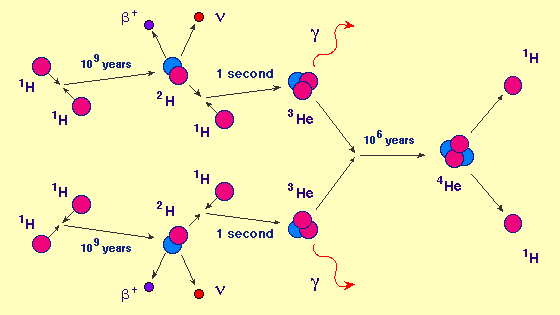 |
A summary of how it works, showing all the reactions and how long it takes for them to occur, is to the left. (From U. Tenn Ast 162, http://csep10.phys.utk.edu/astr162/lect/energy/ppchain.html) |
In stars more massive than the sun, another reaction chain can be important in converting hydrogen to helium. In it, carbon, nitrogen, and oxygen isotopes are critical links although the final mix of isotopes is not modified. In analogy with terminology in chemistry, they are called catalysts. The reaction chain is the "C-N-O cycle".
For two H nuclei, protons, to collide hard enough to overcome their natural electrical repulsion, they must be moving very fast.
==> need very high temperatures
 |
 |
(From Nick Strobel Go to his site at www.astronomynotes.com for the
updated and corrected version.)
To have enough collisions to generate significant energy requires high density
==> reactions can occur only in the centers of massive objects like stars or (at least so far) in special machines where they can be sustained for only a very short time because the energy released disrupts the continuing reaction
Only about 10% of the mass of the sun has temperatures and pressures sufficiently high for nuclear reactions to occur.
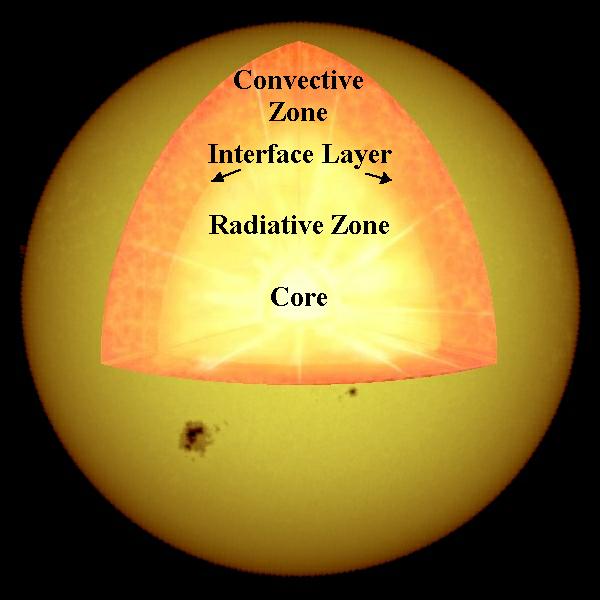 |
The core of the sun, where the fusion takes place, is overlaid by a huge amount of hot hydrogen and helium gas. (From MSFC, http://science.msfc.nasa.gov/ssl/pad/solar/images/cutaway.jpg) |
 |
Neutrinos react extremely weakly with other
forms of matter. They can escape from the center of the sun virtually unimpeded and they
carry away about 2% of the energy from the fusion reactions occurring there. (From Nick Strobel. Go to
his site at www.astronomynotes.com for the
updated and corrected version.) |
Neutrinos are NOT electromagnetic radiation or matter. They are
another type of fundamental particle, similar to photons, but also different from them in
some important ways such as their ability to travel through matter without interacting, so
they can emerge from the center of the sun![]() .
.
Because neutrinos emerge from the very center of the sun, it was thought that measuring how many of them escape would allow us to probe our understanding of the reactions taking place there!
==> Neutrino detectors have found fewer neutrinos than expected.
Is the center of the sun producing energy differently than we think or do neutrinos behave differently than we think or something else? We now think it is the neutrino physics that was wrong and that our models for the interior of the sun are very accurate.
| How does the rest of the energy escape from the center of the
sun?
There are two zones with different types of energy transport: the radiative zone and the convective one.
|
 |
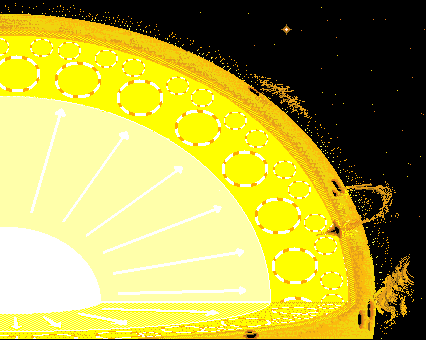 |
Well inside the sun, the gas is so hot it is fully ionized (electrons are all stripped from the atom nuclei), so the atoms are poorly absorbing and the energy is carried by gamma rays that bounce their way off the free electrons. This region is called the radiative zone; within it, there are no large-scale gas motions. About 85% of the way out, the temperature drops to where electrons are retained in atoms and the gas atoms absorb the energy efficiently. The gas gets so hot it expands and rises convectively toward the surface in large-scale blobs. The energy is carried across this "convective zone" by this "boiling" of gas. (From H. Haubold and A. M.Mathai, Encyclopedia of Planetary Sciences, (Page 786 - 794), 1997 Chapman & Hall, http://www.seas.columbia.edu/~ah297/un-esa/sun/sun-chapter1.html) |
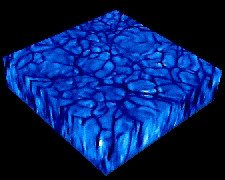 |
The final stage in the convection is the
granules, which are just hot gas rising to the surface. This simulation
shows the process. (Adapted by G. Rieke
from A. Malagoli, http://planetscapes.com/solar/cap/misc/convect3.htm) |
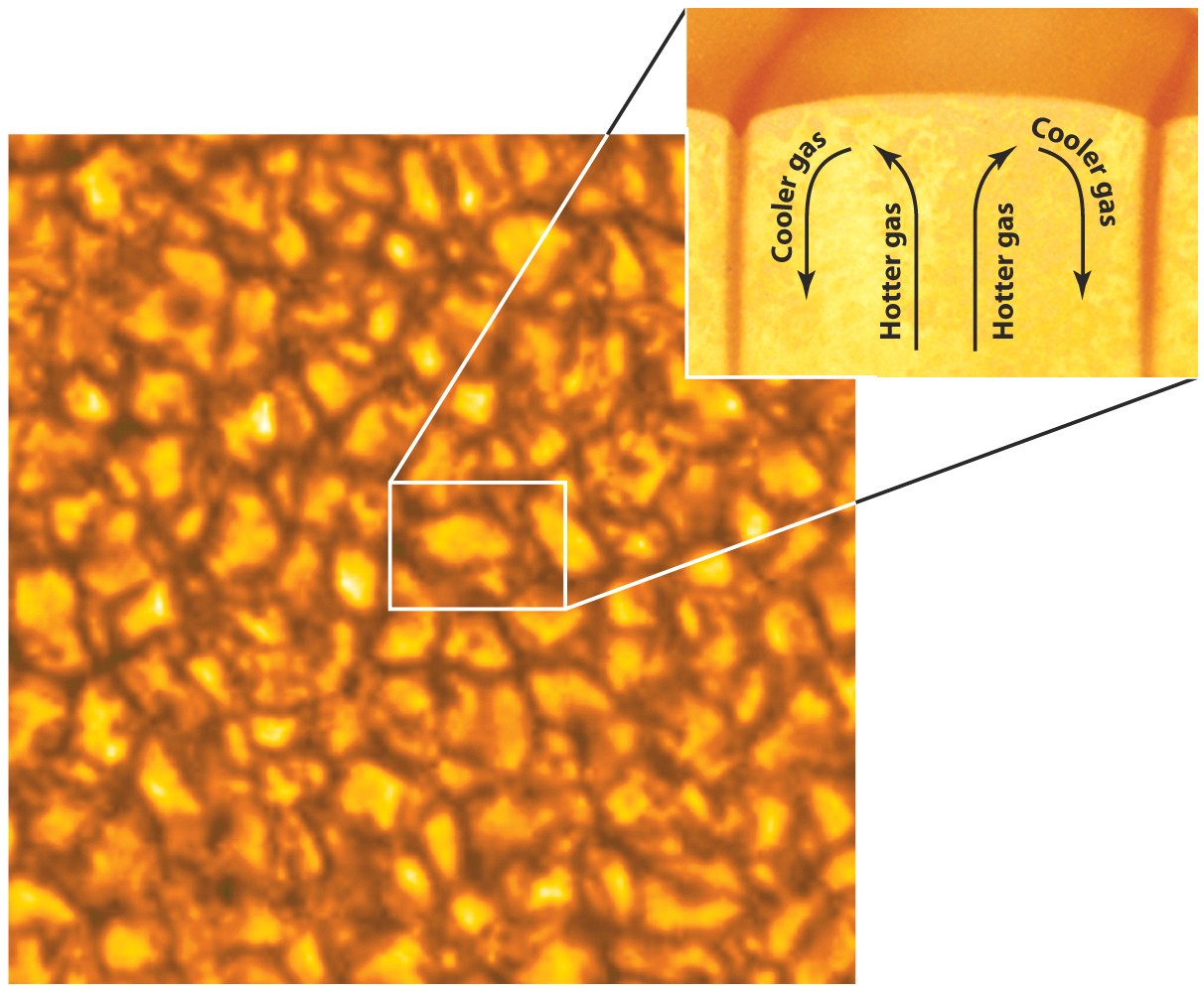 |
Energy rises to the surface as gas wells up in the cores of the granules, and cool gas sinks around their edges (From Pat Hall, http://www.yorku.ca/phall/P1070W05/L21/sec3.html.). |
The motions from convection drive a lot of the magnetic behavior such as sun spots. The convection results in electric currents of protons and electrons that produce the strong surface magnetic fields and drive the surface activity, as shown in this animation of the magnetic fields (blue and yellow are the two magnetic poles, N & S):
 |
The sequence runs from solar max to solar min, showing the dramatic
decline in magnetic activity. The cycle of solar activity is thus associated with changes
in magnetic activity. Adapted by G. Rieke from MSFC solar physics, http://science.msfc.nasa.gov/ssl/pad/solar/dynamo.htm) |
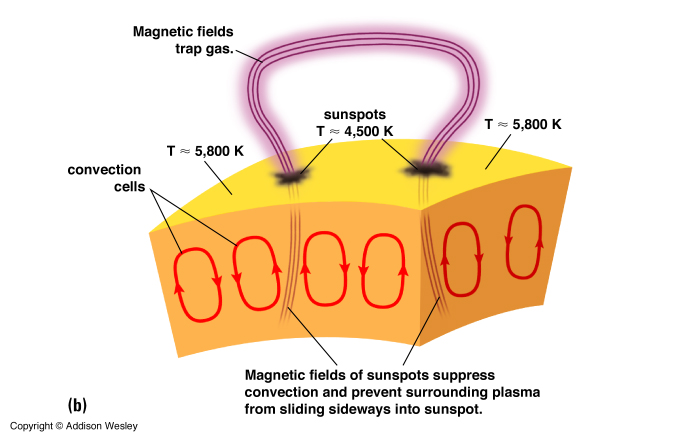 |
Electrically charged particles follow the magnetic field. Where the fields are strong, they suppress convection and reduce the flow of heat, creating a relatively cool region that appears as a sunspot. Charged gas atoms and molecules follow the field lines that connect north and south poles, creating arcs and loops far above the solar surface. {From The Essential Cosmic Perspective, by Bennett et al.) |
So long as adequate amounts of hydrogen remain in the sun's core, it will continue to produce energy at nearly the current rate.
 |
The sun's output is so stable
(variations of less than a percent) because of hydrostatic
equilibrium. The outward pressure of hot gas comprising the sun
exactly balances the force of gravity which tries to make the sun grow smaller. In the stars like the sun, when the star shrinks the core pressure and temperature increase and that increases the pressure, resisting the shrinkage. When the star swells, the core pressure and temperature drop and reduce the pressure, and gravity makes the star stop swelling. (animation by G. Rieke) If the sun produced energy more rapidly in its core, it would be hotter. Then the pressure would increase and the core would expand. The larger, lower density core would have fewer proton-proton collisions, reducing the rate of reactions, and causing the production of energy to decrease. Thus, the energy output is self-regulating. |
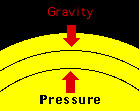 |
The structure of the sun adjusts until the gravitational "pull" towards its center is just balanced by the "push" of the gas pressure outward. Fortunately, this results in a very stable state, called hydrostatic equilibrium. |
Good link on the sun: http://solar.physics.montana.edu/YPOP/
Test your understanding before going on![]()
|
http://www.forthnet.gr/olympics/athens1896/pictures/pics/apollo.jpg |
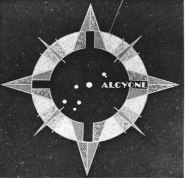
Bright star Alcyone from the inlaid star map at Hoover Dam, http://www.usbr.gov/lc/hooverdam/service/sculptur.html |
|
Click to return to syllabus |
||
| Click to return to the Sun | hypertext |
Click to go to Other Stars |